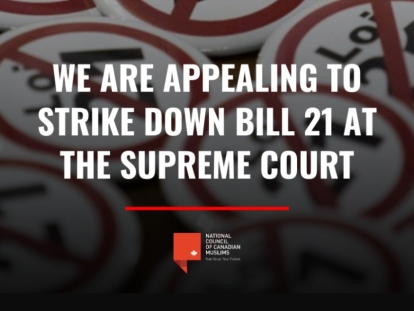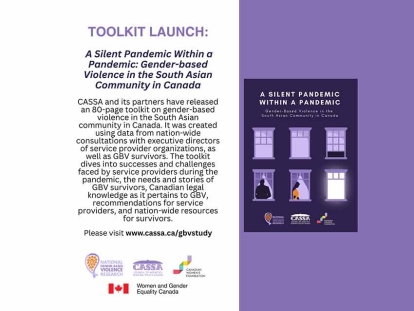 A man walks past a sign in Montreal’s Parc-Extension neighbourhood in August 2019, during a community event where people voiced their concerns about gentrification in the multicultural borough.
The Canadian Press/Graham Hughes
A man walks past a sign in Montreal’s Parc-Extension neighbourhood in August 2019, during a community event where people voiced their concerns about gentrification in the multicultural borough.
The Canadian Press/Graham Hughes
Jan
Parc-Extension: How immigrants are integrating into Montreal’s most multi-ethnic neighbourhood
Written by Yanick FarmerThe sense of belonging that immigrants develop with their host society is not very often reflected in media coverage or speeches by public figures, which tends to focus on activism. What makes immigrants feel like they are part of their host society is, above all, having their basic needs met.
Because of the diversity in Montréal, as well as the competing influences of the French- and English-language cultures, the city is an ideal place to observe the dynamics of immigration and integration and, sometimes, the clash of values.
As a university researcher in applied ethics and communication, I consider it essential to understand how the values and preferences of individuals are embodied or transformed by their life experiences. An immigrant’s interactions with their host society offer a unique perspective on how individuals evolve.
Parc-Extension: A transitional neighbourhood
In order to better understand how migration affects the transformation of values and preferences, I decided a few years ago to focus on the particular experiences of South Asians living in the multicultural neighbourhood of Parc-Extension (or Parc Ex), in Montréal.
This community, whose numbers are growing, remains one of the most misunderstood by Quebecers.
The people who immigrate to Parc Ex come from India, Pakistan, Bangladesh and Sri Lanka. Since the 1970s, they have occupied a growing place in the neighbourhood. The neighbourhood first welcomed immigrants from Eastern Europe, Italy and Greece after the Second World War. Language differences and the fact that the socio-economic status of those living in the community is lower than the average for Montréal and Québec make it more difficult for them to gain social visibility.
According to a recent study by the United Way, 69 per cent of the population of Parc-Extension has a first language other than French and English, and 10 per cent do not speak either official language. Economically, 38 per cent of residents have low incomes and 40 per cent of renting households spend more than a third of their income on rent.
For many South Asians, Parc-Extension remains a “transitional” neighbourhood that they live in when they arrive in the country, but leave when their social and economic status improves. This reality may change in the future, however, as the neighbourhood gentrifies, much to the dismay of many community organizations. This phenomenon is making it more and more complicated for many people to move to — and stay in — Parc-Extension.
My research led me to conduct interviews with about 40 men and women from this neighbourhood. The overall results were published in 2021 in the journal New Diversities.
Three characteristics that promote belonging
The data collected showed that three factors are essential for residents to develop an attachment to the place where they live. The first is the quality of interpersonal relationships. By this we mean relationships with close friends, family, neighbours or colleagues, but also the social interactions of everyday life. In this regard, many South Asians expressed delight in the friendliness of people in their neighbourhoods, and in Québec and Canadian societies in general.
The second factor is the feeling of safety, which is linked to low crime rates and being able to move around freely. This factor was crucial for the women we interviewed, but men also attached great importance to it.
The third factor is the quality of urban infrastructure. This refers to all the facilities and equipment (roads, public transport, libraries, parks, playgrounds, etc.) that can be enjoyed by all. This factor was considered to be as important as safety.
Two other factors were also considered significant, but less so than the first three. These were the quality of social programs relating to health, education and employment, and cultural similarity, such as the possibility of finding certain aspects of the original culture in the host society (grocery shops, places of worship, traditional festivals, etc.).
Meet concrete needs first
In analyzing the data, it became apparent that the factors that reinforce a sense of belonging appear to be strongly determined by the basic psychological needs defined in Maslow’s pyramid. According to the American psychologist Abraham Maslow, security, rich interpersonal relationships and positive esteem from others are among the essential elements for a happy and meaningful life.
The links between the factors that promote belonging and those supporting basic psychological needs also help explain why respondents didn’t consider other factors to be important, even if they are regularly the subject of lively public debates on the issues of immigration and living together.
For example, although this topic was much discussed in the media at the time of the interviews, the issue of secularism and the law banning some public sector workers from wearing religious symbols virtually flew under the radar of the community. In fact, only one person (out of 40), a self-described activist, mentioned it as something that could affect their sense of belonging.
This apparently surprising aspect of the results is actually quite logical. A place becomes attractive, not least of all because of the concrete needs that can be met there. Theoretical debates about laws or models of immigrant integration are far removed from the basic needs of most people. These rather abstract issues are of much more interest to politicians, intellectuals or activists than they are to ordinary people.
When it comes to these hot issues, we unfortunately see what is sometimes a considerable gap between what the mass media or public figures portray and the reality that unfolds every day in the streets and neighbourhoods of our cities. This observation should encourage those who wish to have access to an accurate portrait of current social issues to diversify their credible sources of information in order to develop an informed citizen’s point of view.![]()
Yanick Farmer, professeur titulaire en éthique de la communication, Université du Québec à Montréal (UQAM)
This article is republished from The Conversation under a Creative Commons license. Read the original article.





_1765244389.png)






